How Much & How Often to Water Mums: Tips, Care, & Maintenance
-

- Last updated:
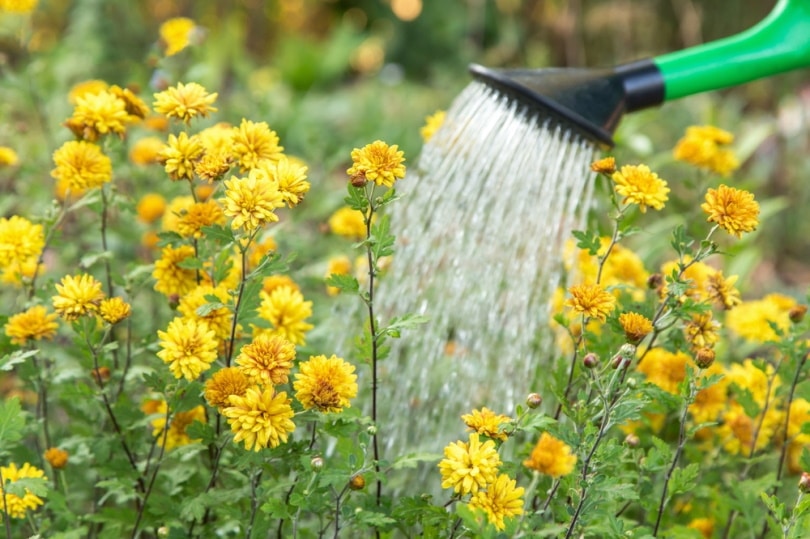
Chrysanthemums are one of the favorite flowering plants worldwide, loved for their decorative and ornamental flowers. To produce such breathtaking flowers, mums need a lot of care. You will need to be attentive and know all the basics. Other than learning how to adequately plant mums or the soil type they require for growth, another crucial factor is how much water you give them. This is the part where a slight exaggeration can mean everything.
To understand just how much water to give to your new chrysanthemum plant, it is essential to know what factors will affect it. The weather conditions, the soil drainage, and the development phase will affect the amount of water your mum will need. Read the rest of this article to find out precisely how much water they will require to thrive and the recommended frequency.
Chrysanthemum Characteristics

| Botanical name | Chrysanthemum x morifolium |
| Leaf color | Green |
| Bloom color | Variety of shades: white, yellow, orange, purple, red |
| Bloom time | From September to frost |
| Size | From 1 to 3 feet |
| Plant type | Flowering perennial herb or subshrub |
| USDA Hardiness zones | Zones 4–9 |
| Soil requirement | Neutral, rich, well-drained soil |
| Sun requirement | Full sunlight to partial shade |
Appearance and Types
Chrysanthemums are one of the most widespread flowering plants for gardens and indoor containers, with single or double flowers on each stem. Depending on the variety, these plants are usually perennial and grow gorgeous daisy-like or cushion-like flowers. There are over 40 different species of mums and countless varieties. Each variety of chrysanthemums has its unique characteristics, especially when it comes to flowers. Flower petals can be erect or droopy, wide or narrow, dense or lonely, and each variety shows something entirely new and different. The most popular varieties of chrysanthemums are:
- Single Mum
- Spider Mum
- Quilled Mum
- Anemone Mum
- Reflex and Incurve Mum
- Pompon Mum
- Decorative Mum
- Thistle Mum
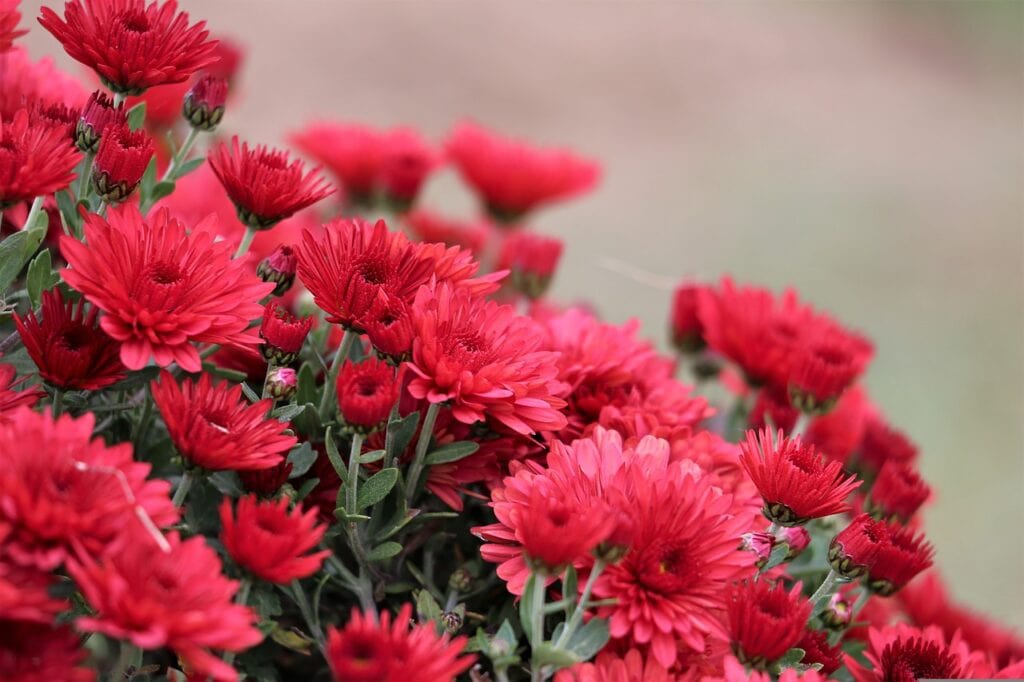
Care and Maintenance
Caring for chrysanthemums is relatively easy once you get the hang of it. Maintenance is straightforward, depending on where you want to plant and grow mums. During summer, these stunning plants require frequent watering and evenly moist soil. Since these are sun-loving plants, it would be ideal to place them in a slightly shaded area during hot summers to prevent burning. It is necessary to provide mums with at least 6 hours of sunlight each day to promote their growth, blooming, and hardiness.
Risk and Diseases
No matter how diligent you are in caring for your chrysanthemums, specific problems are out of your control. Several fungi attack mums and cause leaf spots that present as yellow, dark brown, or black circles on the leaves. These fungi can also cause wilting, powdery mildew, ray blight, ray specks, and gray mold.
Other than fungus-related diseases, certain pests and viruses attack chrysanthemums. Pests like aphids, spider mites, and leafminers are common unwanted guests on chrysanthemum plants, although there are several natural ways to treat them.
When it comes to certain viruses—smut virus, mosaic virus, and tomato spotted wilt virus—they are usually without a cure. To prevent viruses from spreading to your other plants, destroying and disposing of the affected ones would be best.
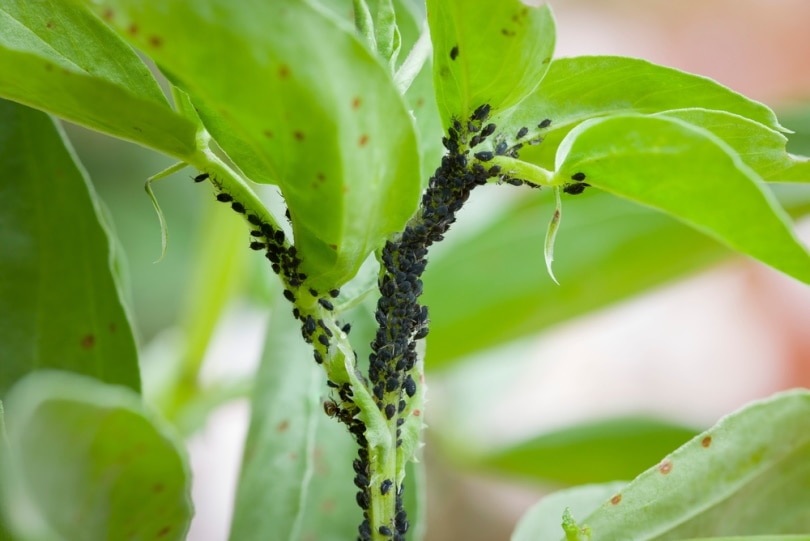
Watering Habits
When watering chrysanthemums properly, there are a few things to keep in mind. The first thing to keep in mind is how to water them, which is best done from the very base of the plant. When watering the plant from its base, you avoid any fungal development. It is always best to look at the soil’s draining properties to know how much water to add.
How Much Water Do Mums Need?
Chrysanthemums require a lot of water to remain healthy and continue thriving. For chrysanthemums specifically, it is vital to develop a good root system. When the plant develops a deep root system, it is more likely to survive droughts and freezing weather. The best way to encourage deep root development is to water the plant 6 to 8 inches deep. During the growing season, it would be best to water mums at least once a week. Mums prefer equally and consistently moist soil, and as long as it’s adequately maintained, no extra fertilizer is needed.
It would be ideal to water your chrysanthemums 1 inch per week. Especially when it comes to potted mums, watering needs to be done in the correct amounts. Any excessive watering can quickly lead to too much moisture in the soil.
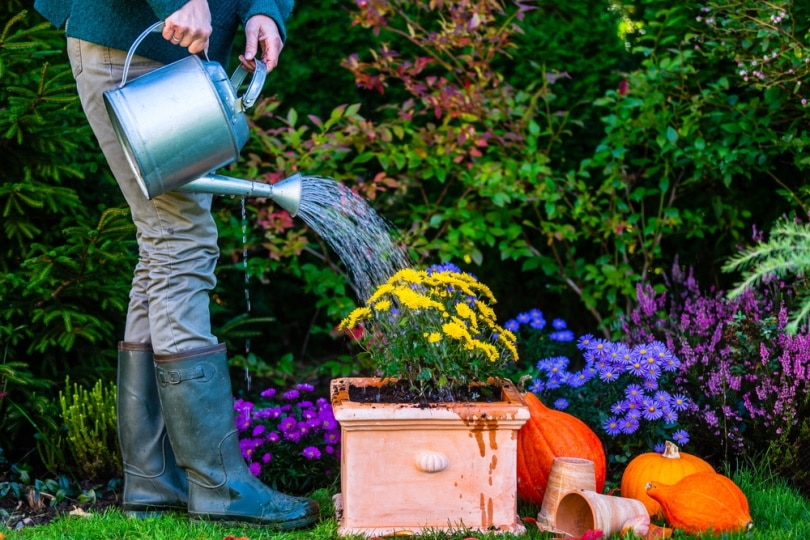
How Often to Water Mums
It is best to monitor the watering habits of mums as they grow and to carefully watch the soil to ensure it doesn’t become too dry. The best way to know when you need to water your mums is to put a finger into the soil and check its moisture. While mums need regular watering and humidity, it is important not to overwater them as it can lead to root rot. Chrysanthemums are very absorbent, so too much water can quickly accumulate at the very base of the pot.
Watering frequency mostly depends on the plant’s location and the particular climate. During hotter and dryer days, the mum will need to be watered at a higher frequency, while the plant can go without watering during rainy weather. Once the ground begins cooling down, you can stop watering your chrysanthemums and cover the surface with a 2-inch layer of mulch. Mulch will help the soil retain its moisture without causing oversaturation.
Tips on Growing Mums
Other than proper watering practices, there are some other tips we want to share with you so you can get the best possible results when growing these lovely plants.
- When buying already grown mums, search for those without any signs of diseases or pest damage, as well as a plant with healthy foliage or blooms.
- To keep the plant healthy and attractive, monitor its growth and snip away any wilting or dead blossoms.
- In colder climates, it is recommended to leave the dead foliage on the plant and not so snip it off, as the plant is more likely to survive the harsh climates that way.
- To encourage the growth of one large flower, you can remove all the side shoots and allow one stem to grow strong.
- You can prolong the vitality of your chrysanthemums by separating them every 3–4 years. Dig them up in spring and divide them along their centers.
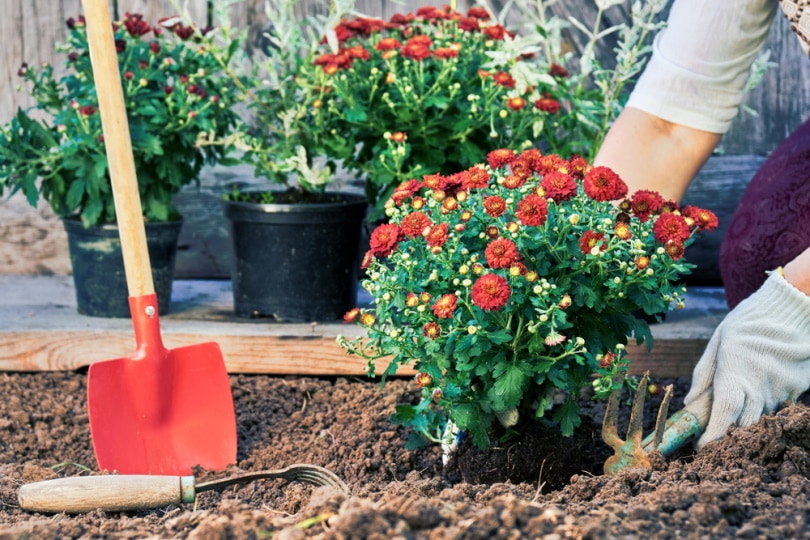
Final Thoughts
With this article, we hope to give you a little nudge in the right direction, so you can go ahead and take care of your chrysanthemum plant on your own. Adequate maintenance won’t be hard once you learn all the right ways. Chrysanthemums are generally forgiving plants, so you must monitor their development and cater to their needs. You will have a thriving, blooming chrysanthemum in no time!
- chrysanthemum | Description, Types, Uses, & Taxonomy | Britannica
- 13 Different Types of Chrysanthemums (Plus Planting Tips and Health Benefits) – Home Stratosphere
- How to Grow Chrysanthemums – BBC Gardeners World Magazine.
- How to Care for Mums | Hunker
- Chrysanthemum Diseases & Insect Pests | Home & Garden Information Center
- How Much Water Do Mums Need?
- How Often Should You Water Mums?
- How To Keep Your Mums Thriving All Season – Farmers’ Almanac.
- Growing Chrysanthemum: Learn How to Plant & Care for Mums.
Featured Image By: Viktor Sergeevich, Shutterstock
Contents

